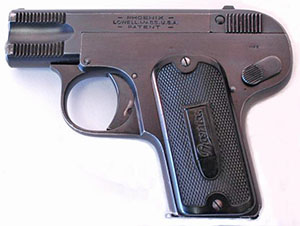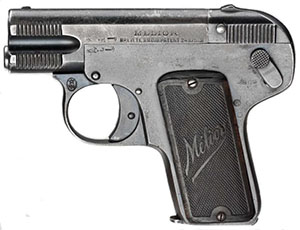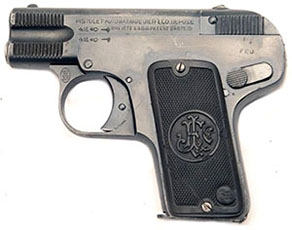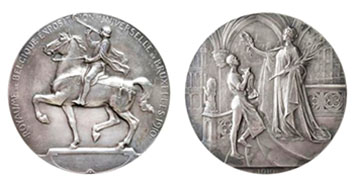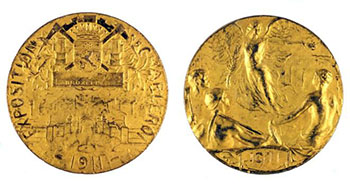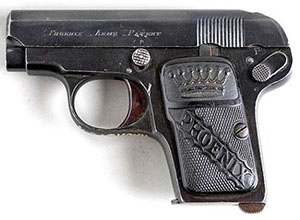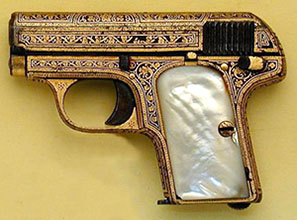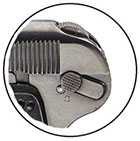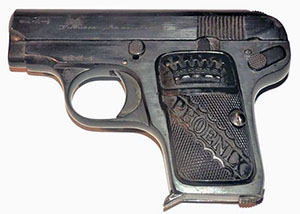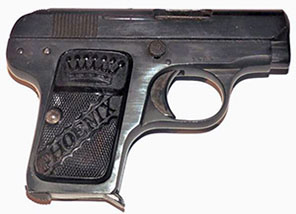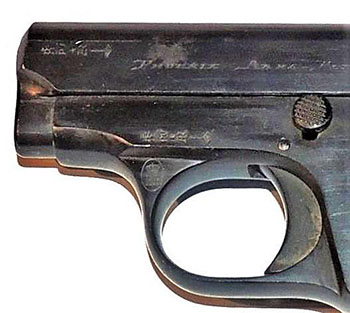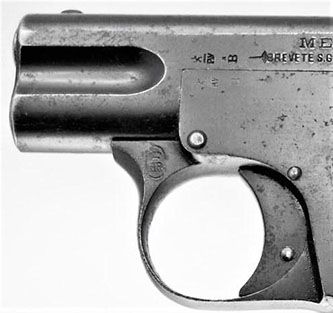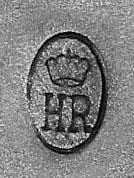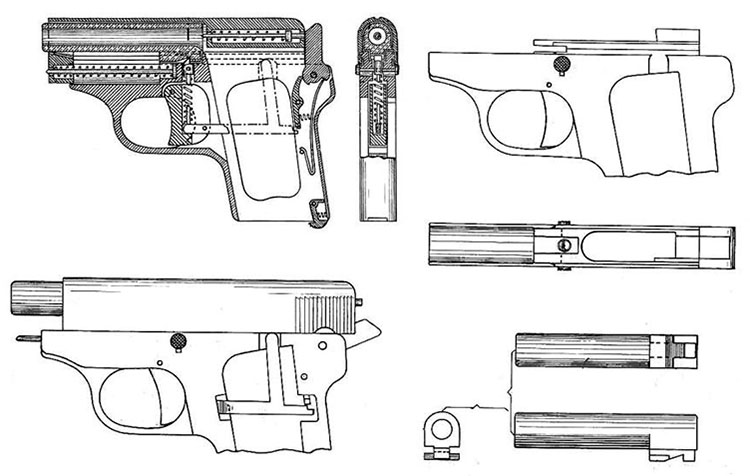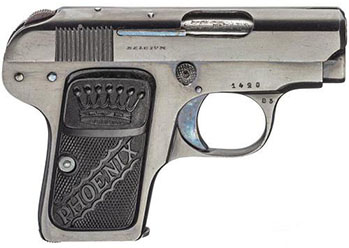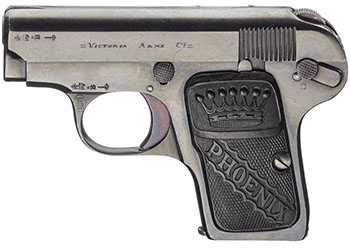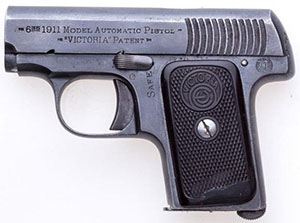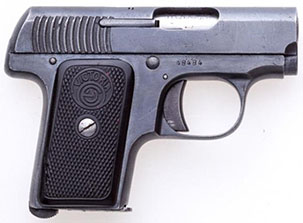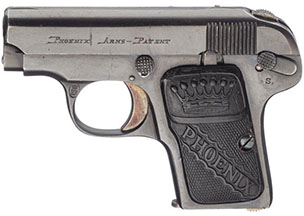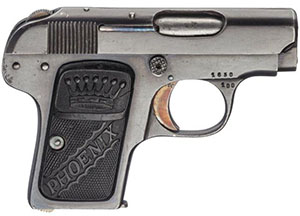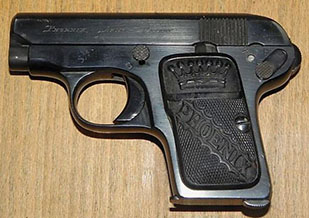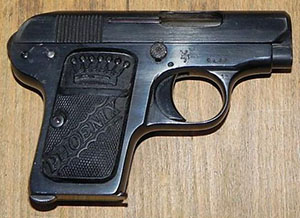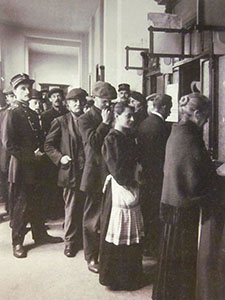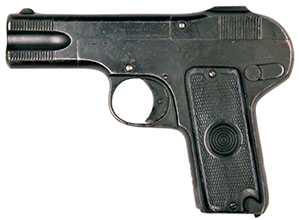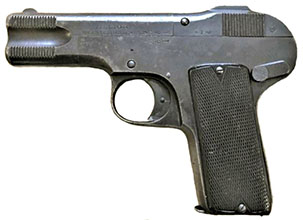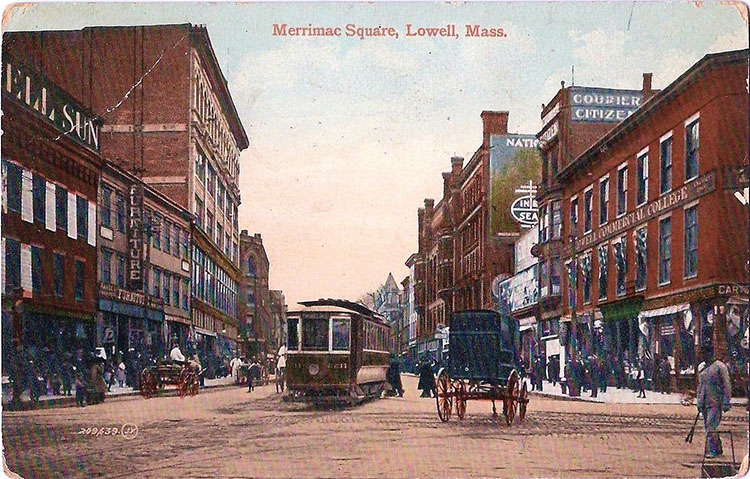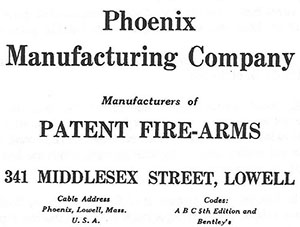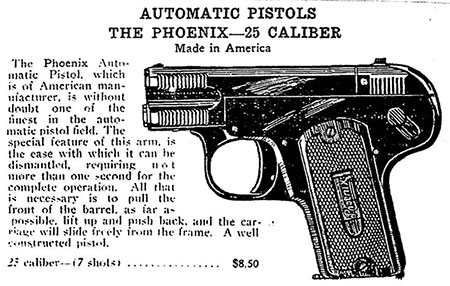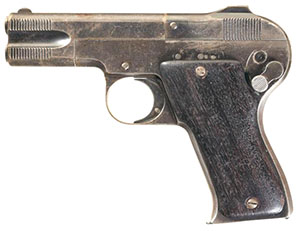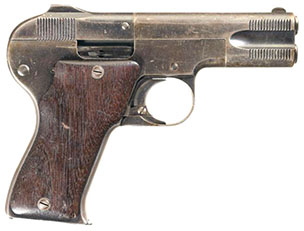 |
||||||||||||||||||||||||||||||||||||||||||||||||||||||||||||||||||||||||||||||||||||||||||||||||||||||||||||||||||||||||||||||||||||||||||||||||||||||||||||||||||||||||||||||||||||||||||||||||||||||||||||||||||||||||||||||||||||||||||||||||||||||||||||||||||||||||||||||||||||||||||||||||||||||||||||||||||||||||||||||||||||||||||||||||||||||||||||||||||||||||||||||||||||||||||||||||||||||||||||||||||||||||||||||||||||||||||||||||||||||||||||||||||||||||||||||||||||||||||||||||||||||||||||||||||||||||||||||||||||||||||||||||||
|
The Rebirth of the Phoenix by Vaclav Vriesen
Most collectors probably also know that the Phoenix pistol is an exact replica of the Melior Model 1912 pistol manufactured by Robar fils et L. De Kerckhove. Both pistols were manufactured under the patent of Henri Rosier. The Melior pistol was also sold under the Jieffeco brand by Janssen Fils & Co., which had a monopoly on the sale of these pistols.
Rosier's Belgian Patent Number 233222 for an automatic pistol was applied for on 17 February 1911 as a supplement to the original Rosier patent of 1907 (Belgian Patent Number 204029) and was issued on 28 February 1911. Similar patents were filed in Great Britain and Switzerland on 12 January 1912, and in the United States on 18 January 1912. All these patents were issued before the end of 1912.
The Liège company Robar fils et L. De Kerckhove had received several awards at international exhibitions: a silver medal in 1910 in Brussels and a gold medal in Charleroi in 1911.
Some sources do not indicate the origin of the gun, but a number of sources seem to think the gun is of Spanish origin. A.B. Zhuk and Albrecht Simon were of the opinion that this gun was produced by the Spanish firm Tomas de Urizar. Perhaps they made this conclusion based on the fact that some pistols of Tomas de Urizar had an image of a zoomorphic mythical creature on the grips, which some have described as the image of a Phoenix, others as a dragon. However, Tomas de Urizar never made a gun with the name Phoenix. The opinion that this pistol is of Spanish origin could also arise due to its similarity with some pistols manufactured by Star-Bonafacio Echeverria. Indeed, the Phoenix has certain similarities with the updated Star Model Number 2 pistol and its trade pistol derivative, the Bronnie. The Bronnie, incidentally, had a deceptive slide legend that suggested it was of Belgian origin, and the name itself is a play on the name Browning.
The primary difference is the absence of an external hammer on the Bonafacio Echeverria pistols, though the design of the external takedown buttons are also different. However, the similarities made it at least possible that the guns were based on the same patent, especially considering that the two makers had connections to a distributor with offices in both Liege and Eibar. The problem with identifying the origin of the Phoenix pistol is that most examples have no markings at all, other than the inscription on the slide, which reads "Phoenix Arms - Patent." My incentive to begin an in-depth study was the discovery of a Phoenix Arms Patent pistol, Serial Number 1484, which has a stamp on the left side of the trigger guard featuring a crown above the initials “HR” enclosed in an oval. In addition, this pistol is marked with Liège proofs.
I immediately recognized this stamp as the mark of Henri Rosier because it appears on the trigger guard of the 1909 Melior pistol.
Confirmation that production of the Phoenix Arms
Later Michel Druart provided me with Belgian Patent Number 257387, issued on 16 June 1913 in the name of Henri Rosier, which details the design of the Phoenix Arms Patent pistol. The Rosier patent of June 1913 describes an automatic pistol with an external hammer in which the barrel is held in place from below by a wedge-shaped plunger fitted into a matching cut in the base of the barrel. The plunger, tensioned by a coil spring, is disengaged from the barrel by two checkered buttons, one on either side of the frame, allowing easy removal of the slide and barrel.
The coil spring that tensions the plunger is situated in the frame behind the trigger. This same coil spring also tensions the trigger and rests against the forward end of the transfer bar. The horizontal transfer bar, which runs on the left side of the gun, extends to a simple pivoting sear mechanism at the rear. A vertical disconnector extends upward from the transfer bar, preventing it from engaging the sear when the slide is out of battery. After a detailed study of the mechanics of the Bronnie pistol designed under a Spanish patent, I have determined that the design of the Star N2 and Bronnie pistol and the Rosier invention have significant differences. Aside from the external hammer on the Phoenix and the internal hammer on the Star/Bronnie, there is also the difference in the external appearance of the release buttons for the barrel. Additionally, the spring for the Bronnie release mechanism does not rest on the front of the transfer bar, and the disconnector is a separate piece rather than being integral with the transfer bar. Clearly, there are similarities in the way the barrel is retained, but the preponderance of proof lies with separate origins for these guns. Henri Rosier, perhaps inspired by inventions of Spanish gunsmiths, nonetheless created a fundamentally new and unique automatic pistol design. Up to Serial Number 1531, all the Phoenix Arms Patent pistols I have had the opportunity to investigate have Liege proof marks and also feature the Henri Rosier stamp. But the earliest known gun, with the Serial Number 1420 on the frame is marked "=Victoria Arms Co=." Please note that the grips have the inscription “Phoenix” with a crown at the top like all other Phoenix Arms Patent pistols, and this gun also carries Rosier's crown over HR stamp.
This Victoria Arms Co. name might confuse researchers and collectors, since today we are used to seeing the "Victoria" brand name on Spanish-made pistols. However, this Victoria pistol is clearly of Belgian origin since it and most Phoenix marked pistols have Liège proof marks. We will address the issue of guns lacking Liège proofs later. In the "Guide to the Identification of Belgian Trademarks and Stamps", there is evidence that two trademarks "= Victoria Arms Co =" and "Victoria," were registered by the firm Thieme & Edeler on 31 May 1913 . Between the observed pistols branded "= Victoria Arms Co =" and "Phoenix Arms - Patent," the interval is only 60 serial numbers. Based on the trademark registration date in May 1913, the time of production and sale of these pistols likely falls in the period between 1913 and 1914. But what prompted Henri Rosier to register his own trademark and rename the gun created under patent No. 257387 as the Phoenix? Thieme & Edeler Thieme & Edeler were arms distributors with an office at 63 rue Wazon, Liege, in Belgium, though it is likely that their company was originally founded in Spain. The company was owned by two German partners, Adolfo Thieme and William Edeler. Thieme was involved in the firearms industry as early as 1897, when he became a partner in the German firm Nimrod Gewerhfabrik, Thieme & Schlegelmich. But Adolfo Thieme and William Edeler formed their partnership in 1909, and never manufactured guns, but rather contracted to distribute guns made by other companies.
Thieme & Edeler was one of the two distributors for ASTRA-Unceta y Cía, which sold pistols under the Victoria brand, the same brand which was later registered by Thieme & Edeler in Belgium. They shared this business with another major seller, Eduardo Schilling of Barcelona, who held the Victoria trademark in Spain. At the time, virtually all of Astra's products were sold by these two distributors. Thieme & Edeler held the rights for sales in Belgium and Austria, whereas Eduardo Schilling of Barcelona held the concession for the Spanish, French and German markets. There was considerable competition between these big distributors for market share. Initially, Eduardo Schilling, the primary distributor for Juan Esperanza and Pedro Unceta (later known as Astra) suggested the name for their Victoria pistol, which revolutionized the firearms industry in Eibar, simplifying the manufacturing process by changing the safety location to above the trigger. Esperanza y Unceta agreed to the idea only to discover later, when the brand became widely successful, that Eduardo Schilling had registered the trademark several years before. Despite the fact that Esperanza y Unceta asked to use the trademark, Schilling refused and claimed exclusive use of the brand in France and Germany. Later Thieme & Edeler probably registered the Victoria trademark in Belgium in order to sell pistols with this trademark in their assigned territories of Belgium and Austria. T&E also registered trademarks that suggested a Belgian origin. This deceptive tactic is often blamed on Spanish manufacturers, but these German distributors were actually the instigators. One example is their use of the well-established Belgian firearm maker’s Manufacture Liégeoise d'armes á feu slide legend by simply adding a Patent Number behind it.
Adding the word "patent" and a patent number was a standard merchandising trick for these companies who wished to sell cheap Spanish guns which they represented as made in Liège. For instance, the following inscription appears on a gun sold by Thieme & Edeler: Manufacture Liègeoise d'armes á feu.soc.An
The patent is a real one, for a loaded chamber indicator, belonging to Juan Esperanza Salvador of Esperanza y Unceta. Thieme & Edeler would have the guns proofed in Liège, and afterwards could sell them in other countries as if they were made in Belgium. Sometimes the distributor would ask the manufacturer to mark pistols with their own brand, or when the distributor did not know what market they would be sold in, they would ask the manufacturer to leave the pistols unbranded. Later, the trading company labeled the weapons according to their interests and in order to improve sales. The grips could have any name on them. Often manufacturers did not know what brands their pistols were being sold under by the distributors. Thus, Thieme & Edeler sold Spanish pistols with Belgian names. These merchants misled customers to improve sales and ended by discrediting the manufacturer who did not know of their marketing practices. Eduardo Schilling often complained that Thieme & Edeler sold pistols in territories entrusted to him, especially France. This strategy of deception angered the manufacturer and when these violations were proven, the relationship between Esperanza y Unceta and Thieme & Edeler cooled and, in 1914, Esperanza y Unceta terminated the contract. After this scandal, Thieme & Edeler closed its office in Liège and maintained only their trading house in Eibar. But the scandal did not change their tactics. Later, over the years, they applied for various trademarks which were often not granted because the names were already in use, including Lignose (1922), DWM (1923), and RWS (1923). In 1924 , the company was transformed into a GmbH with the name "La Espanola de Armas y Municiones" (SEAM) and Thieme & Edeler continued to decorate pistols with patent numbers. Henry Rosier no longer wished to deal with these merchants, so he registered his own trademark. Decline in Production and the Move to America As we mentioned above, up to the Serial Number 1531 all pistols of this model Phoenix were proofed in Liège and were marked with the seal of Henri Rosier. Serial Number 1650 no longer has the Liège proofs, but still has the Henri Rosier stamp on the left side of the trigger guard. During the German occupation of Belgium in World War I the Liège proof-house did not operate. Belgian workers refused to work en masse. As a result, a large number of them were deported to Germany for forced labor. As for the owners of production facilities, the requisition of equipment and inventory destroyed the entire technological structure and production potential of their companies.
During this period, the Germans themselves began to proof weapons made in Belgium, and Henri Rosier stopped marking pistols with his crown over HR stamp. On the Phoenix pistol with the serial number 1728, which is shown in the book Baskische Pistolen & Revolver by the German author Albrecht Simon, we no longer see Rosier's stamp on the left side of the trigger guard, and on the right side of the trigger guard we find the German “Crown over N” nitro proof mark. This confirms that production of the "Phoenix Arms – Patent" pistols continued to take place in Belgium during the occupation. Another of the "Phoenix Arms - Patent" pistols with the Serial Number 2488 has stamps on both sides of the frame, but no proof marks whatever. The stamp is a Norwegian heraldic lion with an ax. This is a "release for sale" stamp applied to any firearms sold by the armed forces in Norway in the post-war period from around 1946 until 1951. Most likely, this Phoenix pistol was captured as war booty from the Germans, and this is how it came into the possession of the Norwegian military.
After Serial Number 1728 and up to Serial Number 3057, no Liege proof marks or crown over HR stamps are observed on any of the pistols studied. The number of known "Phoenix Arms – Patent" pistols with Liège proof marks is 1407. We assume that a total of no more than 4,000 pistols of this model were produced.
In order to survive, several co-operatives were set up to distribute work to gunsmiths to make toys, costume jewelry, jewelry boxes, or decorative paper knives. In fact, it was charity. One of these organizations called Panem Laborem, Bread for Labor, manufactured toy pistols. During May 1918, the looting of the country continued, and much infrastructure was destroyed. Some were in terrible misery: the old, the sick, the unemployed. They and their families had only charity to live on, perhaps enough to keep them from dying of idleness, but not enough to satisfy their hunger, dress themselves, or even warm themselves. Then, on July 1, Liège reported the first appearance of the "Spanish" flu, which was rampant throughout Europe. By the end of the month, many residents were ill. On November 11, around 10 AM, it became known that an armistice had been signed. The news spread rapidly throughout the city, causing great joy. At noon, the Belgian flag was hoisted on the front of the town hall and fluttered merrily over the spires of churches, over monuments, and over the chimneys of factories and coal mines surrounding the city of Liege. But production was in decline and there was a lengthy recovery process ahead. The first post-war test shooting at the Liege proof-house did not take place until 24 February 1919. Louis Robar quickly restored production of his Melior pistols, although at first there was not even enough material to make grips. When existing stocks of grips for Melior pistols ran out he used grips with the logo of his main distributor Janssen Fils & Co.. When the stock of factory grips ran out Robar had grips made from horn and wood.
Henri Rosier's situation was probably much worse than Robar’s and he had to make fateful decisions in order to survive in such a difficult time. Both he and his wife, Marie Leon Rosier, were born in Liege and it was certainly a difficult decision to move. While the details are not known in their entirety, Rosier probably left Belgium at the beginning of the war with his wife Marie and their eleven year old son Toussaint. They were still young enough to start over--Rosier was 39 when the war started. He might have been 40 by the time they left Belgium. First they moved to Birmingham, England, a well-known center for the manufacture of firearms. In 1917 they emigrated once again to the United States. They arrived in New York City on 4 August 1917 and settled first in Hartford, Connecticut. This area of the United States is also a well-known center for the manufacture of firearms. Henri quickly found work in a Hartford machine shop.
Rosier registered for the draft on 12 September 1918. His full name was Henri Joseph Rosier, born in Liege on 12 January 1875. His draft registration card describes him as a man of medium height with gray eyes and brown hair, and also states that he was living in Hartford, Connecticut and working as a filer for the Colt’s Patent Firearms Manufacturing Company. He began calling himself Leon Rosier, using his wife's maiden name. The 1920 census shows him living on Merrimack Street in Lowell, Massachusetts with his wife and son, his younger brother Jean, and an American boarder. He became a naturalized U.S. citizen on 17 January 1921, at the age of 46, and was living at 527 Stevens Street in Lowell. He described himself as a mechanic in his naturalization paperwork.
He assembled a small batch of 6.35mm pistols, probably about a thousand guns. These pistols had the following inscription on the left side: –PHOENIX–
When the inventory of parts was expended Rosier was forced to halt production. Sales may have been disappointing, but he probably also did not have enough capital to buy machinery to manufacture new parts, nor the funds to pay someone else to make them. He would have liked to restore production of Model 1912 pistols in 7.65mm, but the number of finished parts was too small and production was probably limited to experimental samples. One such pistol with the serial number 1 was sold at an auction by RIA, and is the only known example in 7.65mm.
Rosier filed two additional U.S. Patents, one in 1922 for a folding revolver, and one in 1923 for an automatic rifle (see U.S. patent numbers 1,454,454 and 1,520,671). He may have sought buyers for these patents, but there is no evidence of the designs ever having been produced. Records of an Henri “Rossier” requesting a US passport extension at the U.S. Consulate in Strasbourg, France in 1925 suggest that he may have returned to Europe at least once, though we have no further confirmation. According to the 1930 U.S. census, Leon Rosier was still living in Lowell, Massachusetts with his wife. He was employed as a mechanic in a machine shop. Between 1930-34, Henry Rosier, his wife, and his son Toussaint returned to Liege. Rosier again worked as a gunsmith at the Robar factory, and his son worked as a commercial agent. Henry Rosier probably died at the age of 72 in Liege, since he was registered in Liege only until 1947.
|
||||||||||||||||||||||||||||||||||||||||||||||||||||||||||||||||||||||||||||||||||||||||||||||||||||||||||||||||||||||||||||||||||||||||||||||||||||||||||||||||||||||||||||||||||||||||||||||||||||||||||||||||||||||||||||||||||||||||||||||||||||||||||||||||||||||||||||||||||||||||||||||||||||||||||||||||||||||||||||||||||||||||||||||||||||||||||||||||||||||||||||||||||||||||||||||||||||||||||||||||||||||||||||||||||||||||||||||||||||||||||||||||||||||||||||||||||||||||||||||||||||||||||||||||||||||||||||||||||||||||||||||||||
|
||||||||||||||||||||||||||||||||||||||||||||||||||||||||||||||||||||||||||||||||||||||||||||||||||||||||||||||||||||||||||||||||||||||||||||||||||||||||||||||||||||||||||||||||||||||||||||||||||||||||||||||||||||||||||||||||||||||||||||||||||||||||||||||||||||||||||||||||||||||||||||||||||||||||||||||||||||||||||||||||||||||||||||||||||||||||||||||||||||||||||||||||||||||||||||||||||||||||||||||||||||||||||||||||||||||||||||||||||||||||||||||||||||||||||||||||||||||||||||||||||||||||||||||||||||||||||||||||||||||||||||||||||
|
Copyright 2020 by Vaclav Vriesen. All rights reserved. |
||||||||||||||||||||||||||||||||||||||||||||||||||||||||||||||||||||||||||||||||||||||||||||||||||||||||||||||||||||||||||||||||||||||||||||||||||||||||||||||||||||||||||||||||||||||||||||||||||||||||||||||||||||||||||||||||||||||||||||||||||||||||||||||||||||||||||||||||||||||||||||||||||||||||||||||||||||||||||||||||||||||||||||||||||||||||||||||||||||||||||||||||||||||||||||||||||||||||||||||||||||||||||||||||||||||||||||||||||||||||||||||||||||||||||||||||||||||||||||||||||||||||||||||||||||||||||||||||||||||||||||||||||
|
|
||||||||||||||||||||||||||||||||||||||||||||||||||||||||||||||||||||||||||||||||||||||||||||||||||||||||||||||||||||||||||||||||||||||||||||||||||||||||||||||||||||||||||||||||||||||||||||||||||||||||||||||||||||||||||||||||||||||||||||||||||||||||||||||||||||||||||||||||||||||||||||||||||||||||||||||||||||||||||||||||||||||||||||||||||||||||||||||||||||||||||||||||||||||||||||||||||||||||||||||||||||||||||||||||||||||||||||||||||||||||||||||||||||||||||||||||||||||||||||||||||||||||||||||||||||||||||||||||||||||||||||||||||
